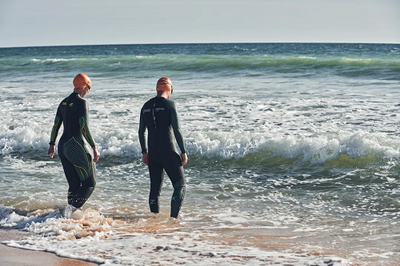What Do Triathlon Wetsuits Do?
-
There are three main functions of a triathlon wetsuit: warmth, buoyancy, and streamlining.
Warmth
A triathlon wetsuit is thick enough to keep the swimmer warm, but thin enough to allow for mobility. The wetsuit forms a thin film of water next to the skin, insulating it from the colder water outside.
Coverage is the most important factor in determining how warm a wetsuit is. Sleeveless triathlon wetsuits are better suited for warmer waters and allow for a wider range of motion for the arms and legs. Full-body triathlon wetsuits keep you warm in most swimming conditions. The wider coverage also creates a barrier between you and rocks, kelp, and aquatic wildlife. However, they do not provide the freedom of paddling that sleeveless triathlon wetsuits do.
Buoyancy
Triathlon wetsuits are made with neoprene fabric to help you float. These panels are usually added to the torso and thighs to hold up the heaviest parts of the body and keep the swimmer in a flat, neutral position in the water. The less energy you use to maintain an optimal swimming position, the more energy you can put into propelling your body forward, resulting in a shorter swim time.
Fluid Dynamics
Another benefit of racing in a wetsuit is that it allows for better hydrodynamics, as triathlon wetsuits are made of ultra-smooth neoprene and rubber. This reduces friction, allowing you to glide effortlessly through the water.





